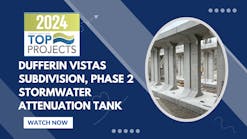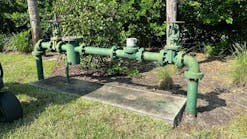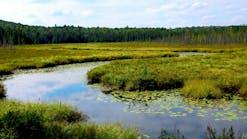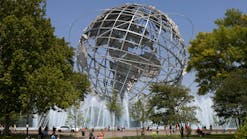Project Profile: Thermoplastic Pipe Points to Savings for New Los Angeles Community
The expanding Porter Ranch community just northeast of the city is one of the first developments in the Los Angeles area to use an engineering grade of thermoplastic pipe for stormwater drainage.
The Toll Brothers’ project, which includes several villages and a 50-acre park, is in the process of building some 900 homes and condominiums to be completed during the next five years. According to a company news release, the Porter Ranch community offers homebuyers a range of award-winning designs, gated villages, top-rated schools, and some of the best hillside views of Southern California. It was this goal of keeping the aesthetic appeal of the development that led to the design of roads to follow the contours of the land. The master plan called for the underground stormwater pipelines to follow the road layout. The thermoplastic pipe from Advanced Drainage Systems Inc. (ADS) could be cut and assembled with the bends and angles required, and could reduce costs and provide watertight joints.
One of the early challenges encountered during the project, Petke noted, was that any materials installed in the City of Los Angeles must be pre-approved by the Bureau of Engineering's Materials Control division. "ADS did the extra tests and work to get the approvals through the City so that it was all keyed up and ready to use,” he said.
“The pipe is slightly oversized in the park by using a larger diameter—42 versus 36-inch,” he said, “so we could hold the maximum cover.” The entire system is rated for a 50-year storm event.
ADS HP Storm is a high-performance polypropylene pipe for gravity-flow storm drainage applications that couples polypropylene resin technology with a dual-wall profile design for superior performance and durability. The smooth interior wall offers additional strength as well as superior flow. The polypropylene pipe meets ASTM F2736, ASTM F2881 and AASHTO M330 for the respective diameters. Also, this polypropylene pipe is approved for use by the Army Corps of Engineers for storm drainage applications under Section 33 40 00 of the Unified Facilities Guide Specifications. HP Storm pipe has an extended, reinforced bell with a polymer composite band and gaskets that add an additional factor of safety within each joint. The joint performance meets or exceeds the 10.8 psi laboratory performance standards per ASTM D3212 requirements. The ADS plant in Madera, California, manufactured and fabricated the fittings and lengths of pipe with special angles.
“There’s always the consideration of maintenance at the end of the day,” Petke stated. “While the Porter Ranch Homeowners Associations (HOAs) are responsible for maintaining the system, it was designed to Los Angeles standards as if the city would maintain it. The city is always concerned that they may have to take over the maintenance in the future and so the city reviews the plans with that in mind. Ultimately the HOAs are responsible for the storm drain. The city park portion will be maintained by the Department of Recreation and Parks. It’s just standard maintenance every couple of years.”
For Porter Ranch Tract 50505, a portion of the stormwater flows in a natural channel that then flows into a box culvert under the 118 Freeway, eventually reaching the Los Angeles river on the south side of the San Fernando Valley. The westerly portion of the stormwater drainage line for the park also ties into that system.
“We’ve used the ADS pipe before and it’s worked well," Petke said. "Plus, the clients like the cost savings." SW
Steve Cooper has reported on water industry projects for several decades, conducting interviews with professional engineers, contractors, government officials and representatives of major companies supplying the industry.
Published in Stormwater magazine, August 2021.







